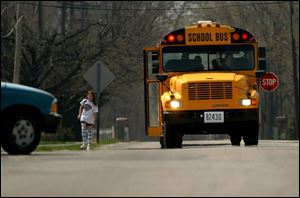
School districts act to reduce use of fuel
11/2/2005
A student gets off a school bus on Curtice E-W Road in Curtice. The higher cost of fuel to power their buses is a major concern of school districts throughout northwest Ohio.
Schools are not immune to higher fuel and heating costs, and administrators say that could mean chillier classrooms this winter, fewer field trips, and stricter guidelines for bus drivers.
Every penny counts for many of the cash-strapped school systems in northwest Ohio, such as Swanton Local Schools in Fulton County, which is one of many that has severe budget woes and failed levies.
"You have to watch to see whatever you do is really going to save you some money," said Neil Weber, the district's interim superintendent.
Swanton schools hired Direct Digital Corp. of Bowling Green last month for $6,500 to find ways to save on energy costs.
Mr. Weber said the investment has been nearly repaid through the measures the company enacted. District officials are now cutting corners by allowing heating and air conditioning systems to cycle on and off.
Scott Ebright, spokesman for the Ohio School Boards Association, said districts planned for higher costs, but not the kind of diesel price surges that have hit the country and those now anticipated in heating.
"I think all schools are lowering the thermostats and cutting back," he said.
Washington Local Schools in Lucas County has mandated all thermostats to 70 degrees this winter, down from about 72 degrees last year.
David Bringman, the district's business manager, said those two degrees can mean a lot of cash.
"We have put in energy-management systems for all the buildings that turn the heat off and on," he said.
Other school districts, such as Perrysburg in Wood County, Port Clinton in Ottawa County, and Toledo Public - the region's largest with 31,000 students - plan to turn classroom thermostats even lower, to 68 degrees.
"We are not turning on the heat as early as we used to, and we are turning it off earlier," said Dan Burns, TPS chief business manager.
The skyrocketing costs have led to some drastic measures at schools nationwide, including canceling a school day and for-getting about cutting grass.
J.C. Benton, Ohio Department of Education spokesman, said every district in Ohio was sent a list of ways to save on heating and fuel costs.
The suggestions for reducing bus fuel costs included a review of all routes and eliminating all engine idling time. The recommendations also include eliminating all "nonessential trips - including field trips and athletic trips," and reducing transportation service to the state minimum.
Districts are only required to transport students in kindergarten through eighth grade who live more than 2 miles from their schools, according to state minimum busing standards.
Mr. Benton warned that two options discussed elsewhere in the country - implementing a four-day educational week and charging students for transportation - are illegal in Ohio.
The Evergreen Local School District in Fulton County is trying to save on fuel by working to keep field trips within a 30-to-50-mile radius, Superintendent Ken Jones said.
Tiffin, Fostoria, and Sylvania schools have instituted a new idle policy for the districts' buses, and have consolidated bus routes to try to save on fuel.
In the Tiffin school district in Seneca County, buses cannot idle for more than five minutes, and officials have eliminated two bus routes by ensuring all buses are filled to capacity, said Tom Anway, director of operations .
Fostoria school officials ordered that buses cannot idle more than eight minutes, and routes in the district that straddles Seneca, Wood, and Hancock counties have been consolidated to make them shorter and more efficient, said Suzette Weiler, transportation supervisor
Ms. Weiler said even though buses were driven 340 fewer miles for field trips so far this school year over last, fuel costs have doubled.
"We're trying to cut corners wherever we can and still ensure safety and the students' getting to where they need to go," she said.
Several southeastern Michigan school district officials were contacted for comment yesterday but did not return phone calls.
Contact Ignazio Messina at:
imessina@theblade.com
or 419-724-6171.